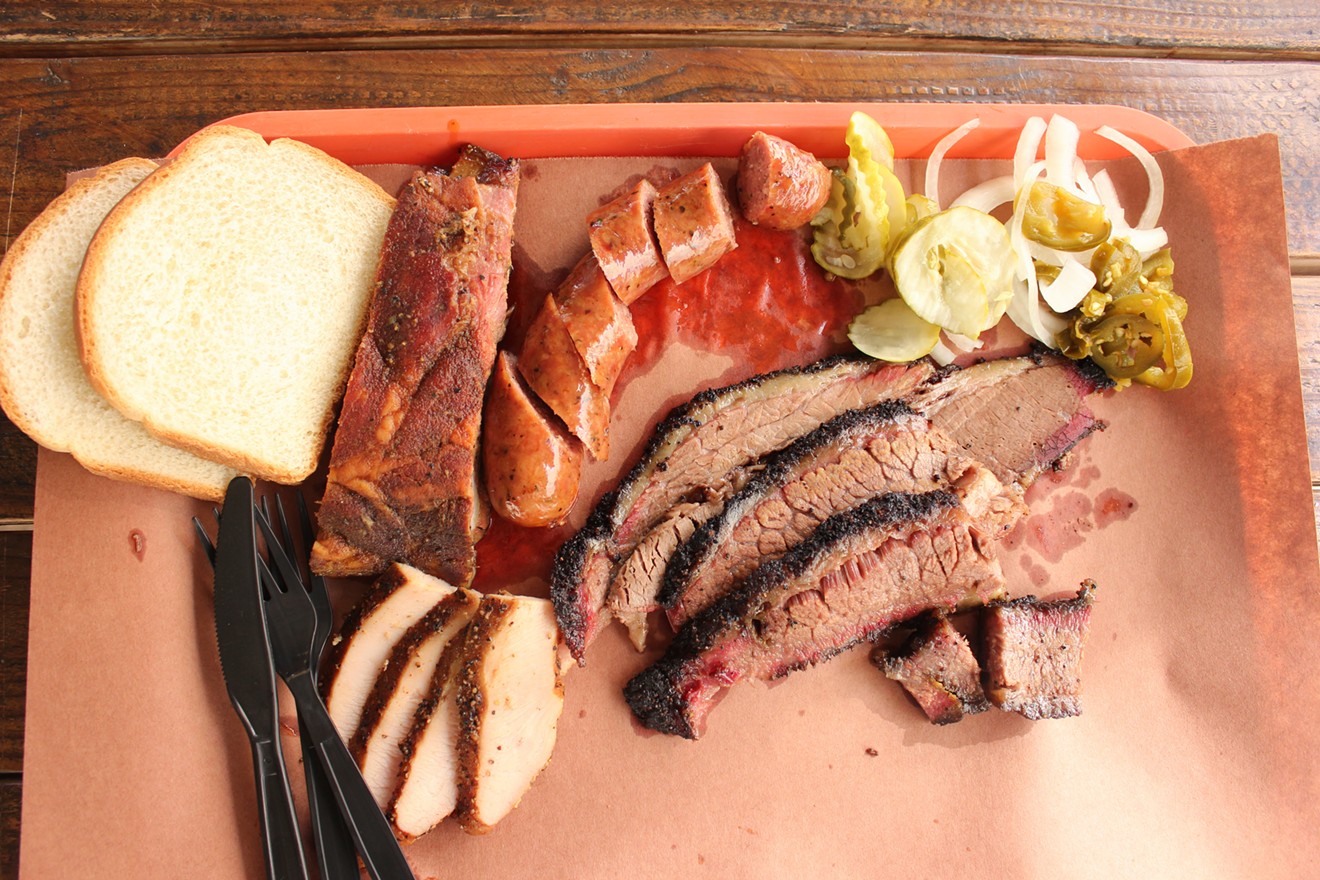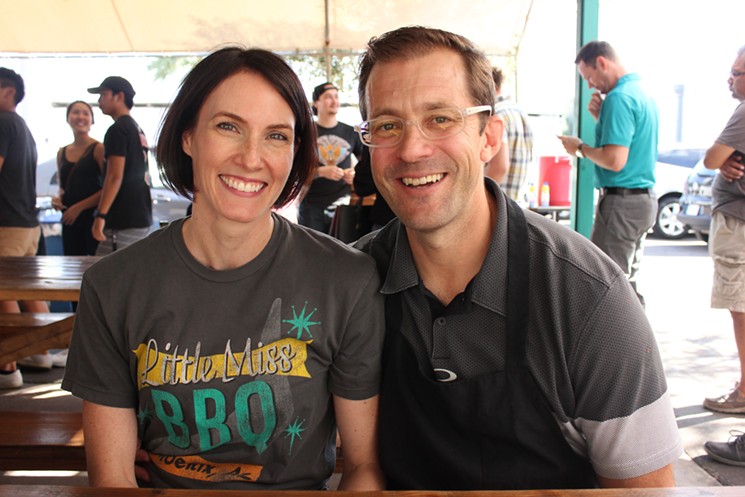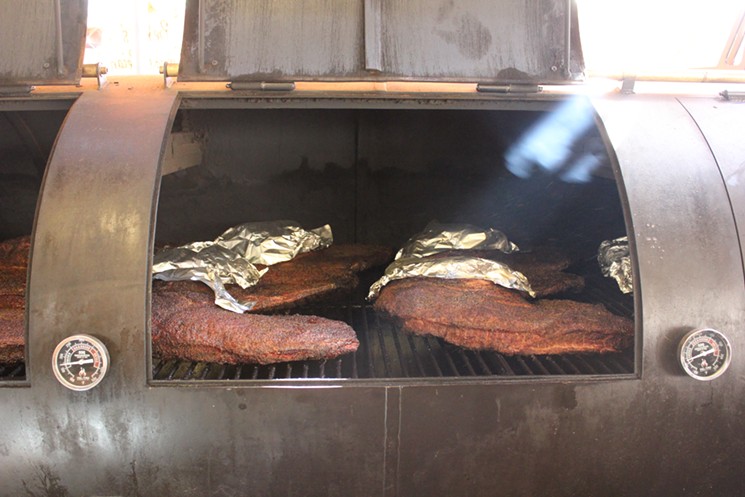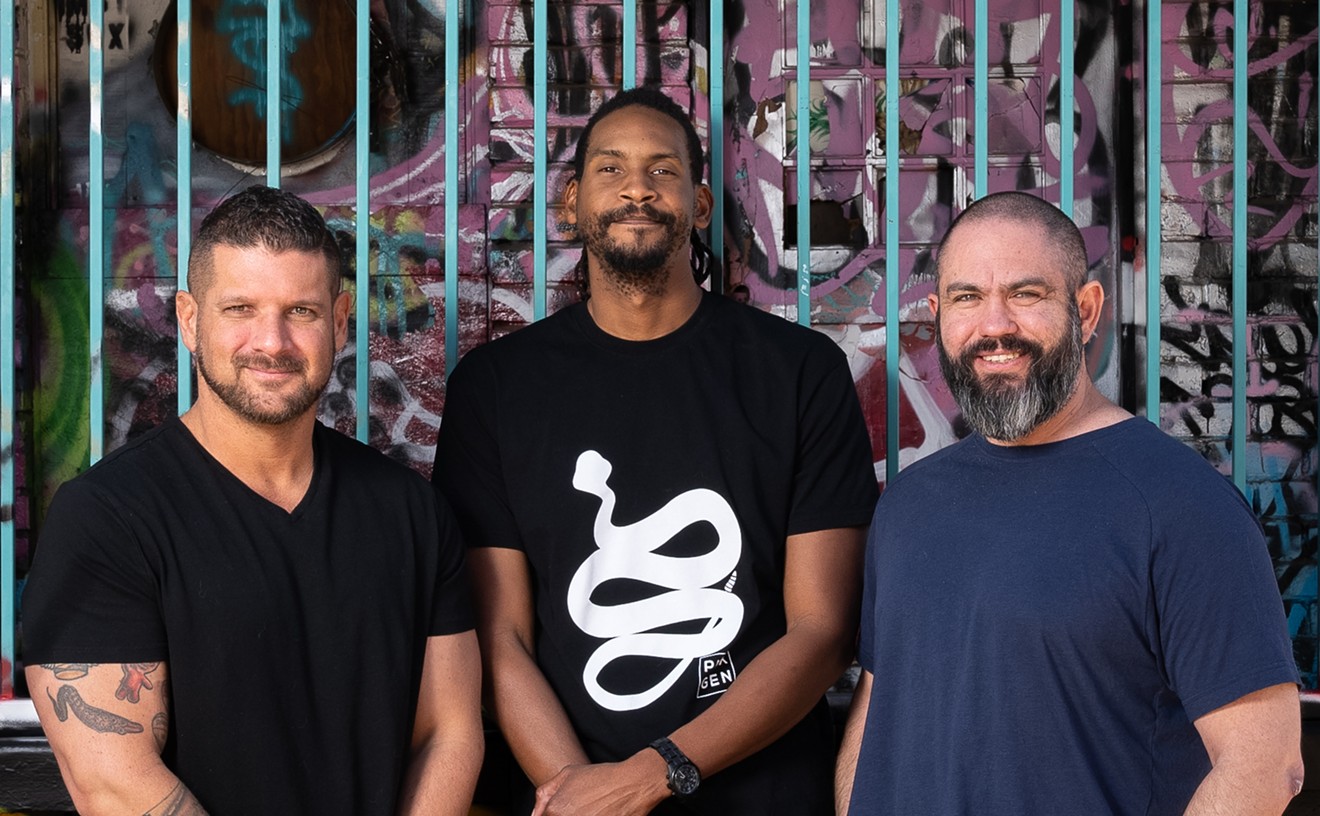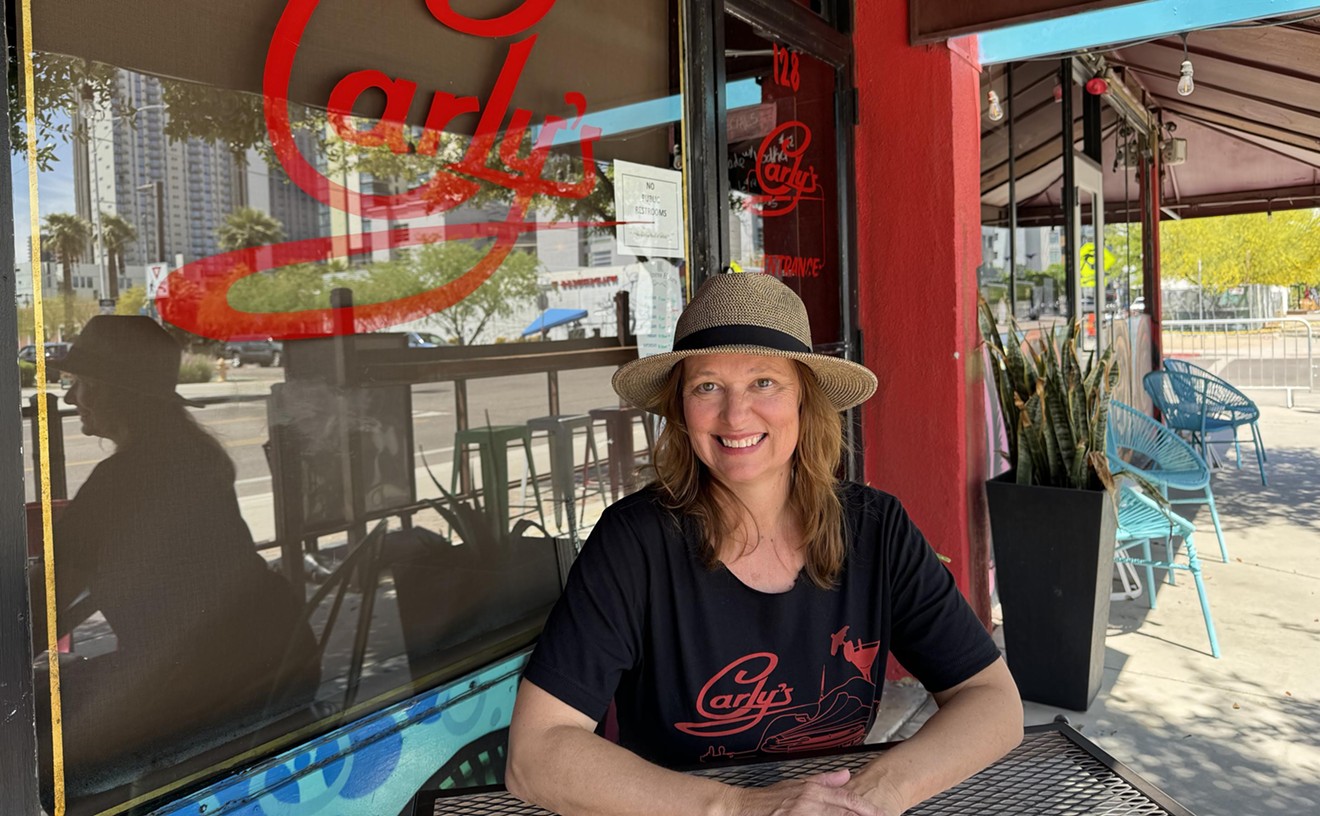The path of Scott Holmes’ life was altered when he traveled to meet the parents of his now-wife, Bekke Holmes. Bekke's parents live in Austin, arguably the world's greatest barbecue city. The couple landed in Austin. Bekke’s parents, waiting at the airport, opened their car’s trunk. A cooler was in the back. The four were off to eat barbecue.
Bekke’s parents took Scott to Salt Lick BBQ in Driftwood, Texas. Salt Lick is a Texas legend.
“It’s an old building made of Stone,” Scott recalls. “You walk in and there’s a giant pit. You’ve got briskets, pork ribs, sausages hanging down. It’s just the coolest thing ever.”
When he returned to Phoenix, Scott bought a smoker.
At this point, Scott had been out of the professional cooking game for a while. As a hobbyist, he started smoking meat on holidays and weekends. He and Bekke started to enter barbecue competitions. All said, they spent four and a half years on the competition circuit, entering 10 to 15 a year.
Their competition mantra was “exceptional generic barbecue.” In 2014, when the two opened Little Miss BBQ on East University Drive, they kept the same focus. What does “exceptional generic” mean?
“Super simple,” Scott says. “Just really good brisket. Try not to have anything weird going on.”
Little Miss BBQ smokes and serves in the Central Texas style. The style consists of minimal rubs, use of oak and mild woods, sauceless meat, brisket, and quirks such as doling out meat on butcher paper and with sliced white bread. Scott isn’t afraid to experiment. He takes some wildly novel positions despite claiming no barbecue weirdness. He has a fine-tuned sense of when to stick with custom and when to split, and that’s what makes Little Miss BBQ the best I’ve eaten in Phoenix.
If I had infinite hunger and time, I could sit at Little Miss eating fatty brisket forever. In your mouth, the brisket feels almost like custard or melted cheese. The sinews holding the meat together offer zero resistance. What you get is a dissolve coupled with a blast of intense flavor. The rub has chew and stick, making the meat’s vanishing act even more magnificent.
What sets Little Miss BBQ apart?
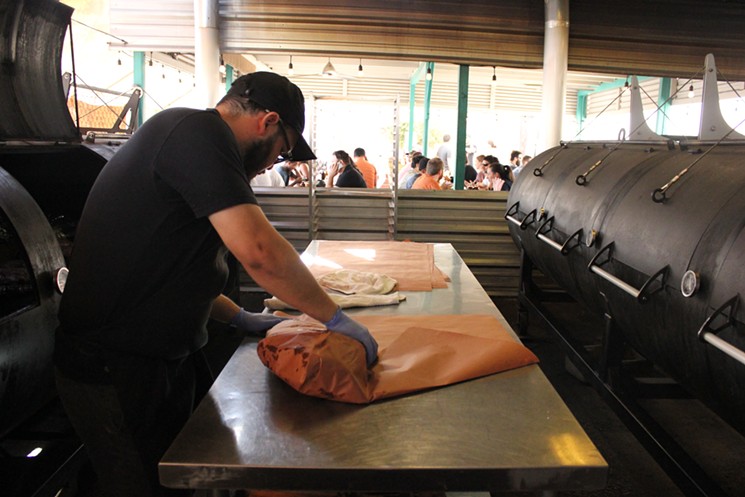
In Central Texas tradition, finished briskets are wrapped in butcher paper to preserve juiciness.
Chris Malloy
To have great barbecue, you must have a great place to chow. Little Miss’s porch is just that. Tunes bathe picnic tables where a mushrooming crowd of brisket-seekers awaits an 11 a.m. opening like kids await the midnight showing of Harry Potter. String lights hang, smoker hinges wail, the thwack of wood being chopped resounds, and fireboxes puff. An aura of community flows; you get a thrill that you’re alive and there.
But—let’s be honest—Little Miss’s three smokers seal the spell.
Most Phoenix barbecue spots use gas-assisted smokers. These use propane to keep heat at a certain temperature. Gas-assisted smokers are commercially available, and the best ones will set you back a few grand.
Scott, pitmaster at Little Miss, built two of his three smokers from 1,000-gallon propane tanks. The third is an R&O from Texas. Each of his smokers runs on the heat of a wood fire—and nothing else.
Why does this matter?
Strap on your oxygen mask. This is going to be a deep dive.
Scott uses “offset” smokers. The way offset smokers work depends on three parts. First: the propane tank on its side. This is the chamber where the meat will smoke. Second, on one end of the chamber, attached but outside and low to the ground, is the firebox. The firebox holds the wood the pitmaster alights. At the far other end of the propane-tank-turned-chamber, the smokestack rises. Shaped like a pipe, it gives smoke an exit.
Say the meat is loaded. Say we’re ready to smoke up. We light the fire. The fire, needing oxygen, pulls in cool air, which pushes its warmer air into the chamber (with our briskets). A convection effect is created in the chamber, the air flowing up and down and around the meat. That air, once on the other end, escapes through the smokestack. The run of airflow through the chamber is constant so long as the fire burns.
“We get a ton of air flowing with these,” Scott says of his offset smokers. “We believe it helps render the fat better than something where there’s a really high moisture environment.”
Gas-assisted smokers don’t have a continuous inflow of fresh air. Rather, the same air lingers in the insulated chamber throughout the smoking process. Because the chamber is closed to the outside world, everything inside stays wetter. The process is more fixed and hands off. You don’t have to worry about the size of the fire, the convection inside the main chamber, or how hard the smoker’s smokestack pulls.
Not only is Scott masterful in his use of offset smokers, he has tailored his smokers to his liking. The first offset smoker he got was the one from Texas. Based on his experience with it, he made changes when rigging his second and third.
Superior smoking equals superior barbecue.
A few other factors set Little Miss apart. One is use of rub.
The 24 to 27 briskets that Little Miss can load into a 1,000-gallon smoker at a time are rubbed with a blend that strays from Central Texas tradition. There are some in Central Texas who hold that brisket should be rubbed with just salt and pepper. Nothing else. The point of this minimalism is to cast a stronger light on the meat.
“To season brisket, you can play with different seasoning recipes,” writes Scott Roberts, pitmaster at Salt Lick, in his Salt Lick Cookbook. “Some people just use salt and pepper. Others use a lot of spices. For the Salt Lick, we keep it to a simple three ingredients: salt, pepper, and cayenne pepper.”
Scott (Holmes) uses a brisket rub that combines a handful of spices and coarse salt and pepper. The rub doesn’t add much pizzazz in the way of flavor—keeping with that minimalistic Central Texas approach—but departs from tradition some in its ingredients. The key feature of the rub is its three-dimensionality of it once cooked—the heft, the height, the chew.
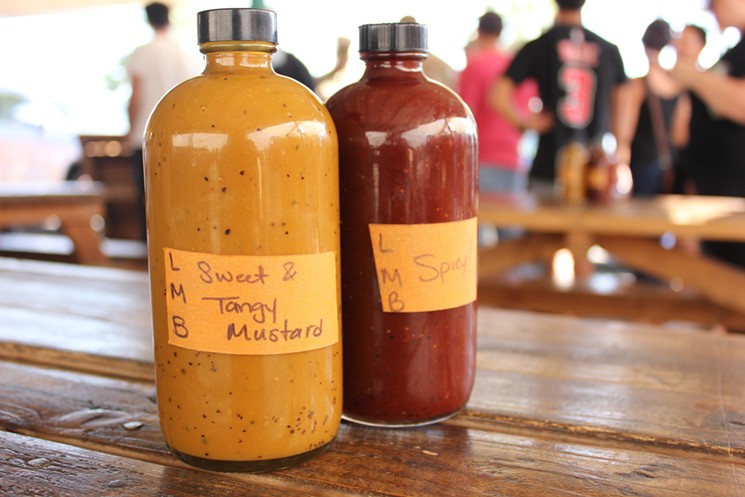
Scott and Bekke Holmes also make some pretty eye-opening sauces. The mustard is mild and unusual but solid.
Chris Malloy
Most barbecue joints use the same wood every time. Little Miss uses mostly two kinds of oak (one from Roosevelt Lake), Arizona pecan, or pistachio wood. But that’s not all.
“We’ve had days where we’ve cooked all mesquite, all orangewood,” Scott says. “We’ve used all cedar. We’ve used all eucalyptus. We’ve used olive wood. Nobody knows the difference.”
Scott is a wood wizard. He loves using olive wood to put a delicate smoke on links, stuffed in-house from odd bits leftover from his other meats. He can expound at length on how vertically split cords will burn compared with rounds, and on why this matters. But when Scott says nobody knows the difference, he is dead wrong.
When I visited Little Miss, Scott and I shared a barbecue platter. We ate brisket, sausage, ribs, and surprisingly juicy turkey. I asked him what wood type he used to smoke the meat before us. He wasn’t on smoking duty the night before, and he didn’t know.
That is, until his next bite of brisket. He chewed quickly, looked to be in deep thought for a heartbeat or two, and nodded. He said, still chewing: “predominantly pecan.”
Barbecue Joint(s): Little Miss BBQ
Smoke Master: Scott Holmes
Wood: Oak (post and white), Arizona pecan, and whatever Scott can get his hands on.
Highlights: Fatty brisket, beef short rib, burnt ends (passed out to folks waiting in line)
Notable Specials: Pastrami (Thursday), beef short rib (Friday and Saturday)
Quirk: A line forms well before the 11:00 a.m. opening. Get there early and come hungry. Fatty brisket usually runs out by 1:00 p.m.
Contact/Hours: 4301 East University Drive; 602-437-1177
Tuesday to Saturday 11 a.m. to 4 p.m (or until sold out); closed Sunday and Monday

